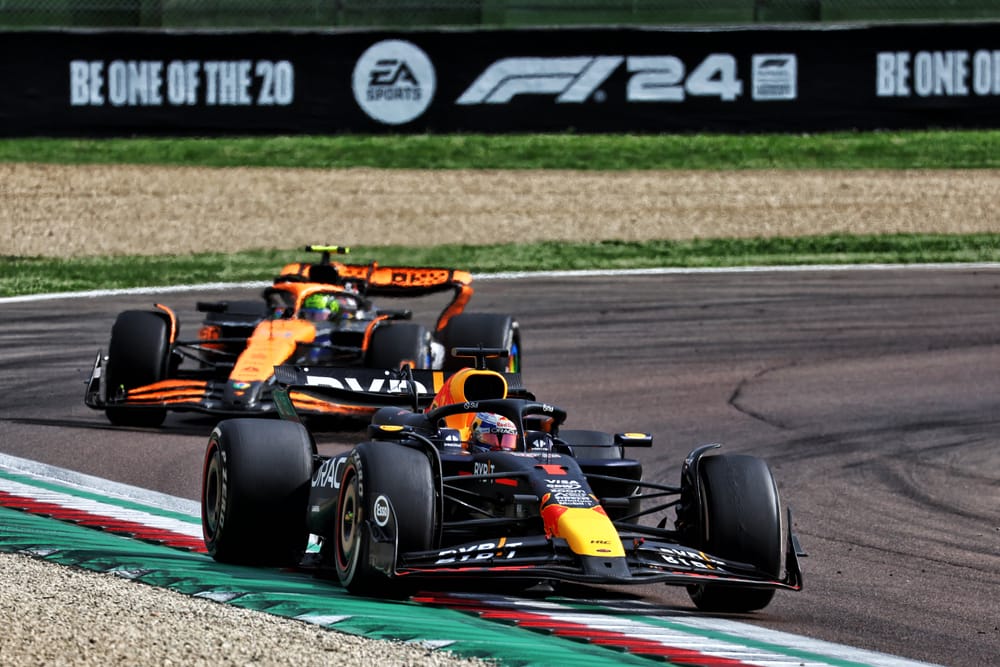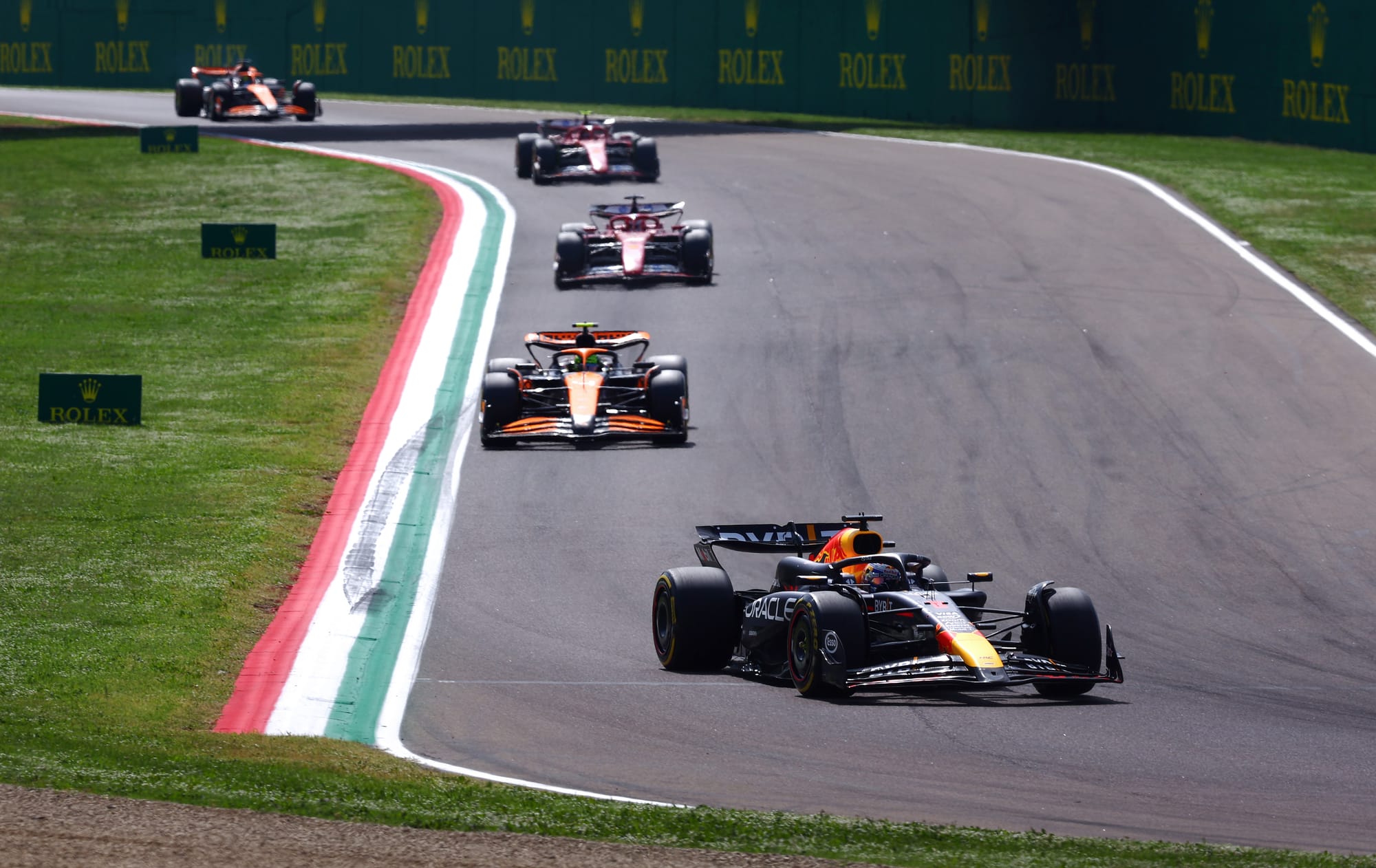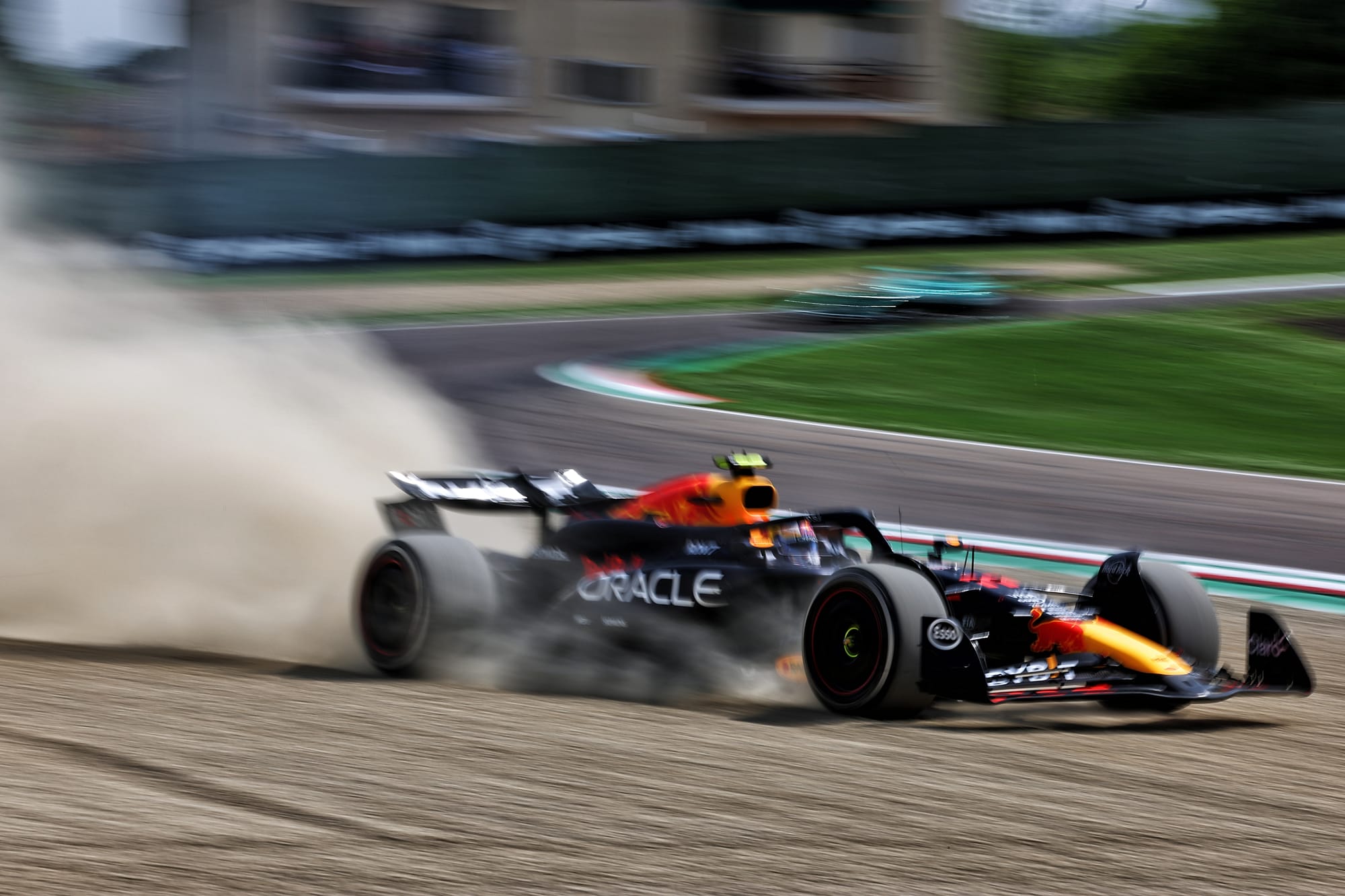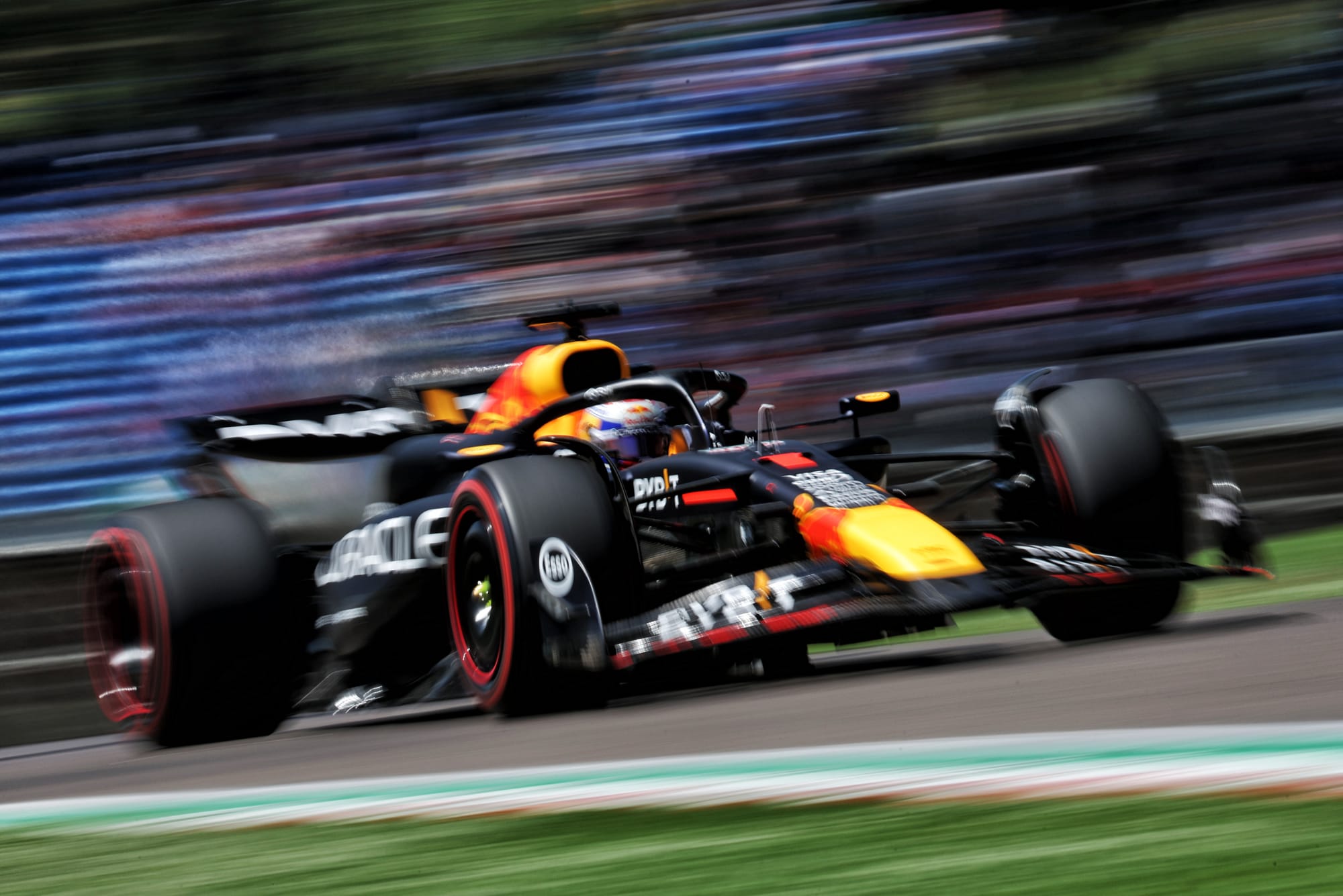Up Next

This was a slow burner which built up into something approaching a dogfight as Max Verstappen was having to resort to playing with the trade-off between battery level and power unit clipping, to braking before the DRS detection point to force the pursuing Lando Norris to lose momentum to keep him out of reach. All this as the laps were counting down towards the end of the Emilia Romagna Grand Prix.
It hadn’t looked like it was going to be this sort of race when Verstappen made his routine single stop on lap 24 with a lead over Norris of over six seconds. Any battle looked more likely to be between Norris and Charles Leclerc’s Ferrari for second.
It looked that way until about halfway through the second stint too, with Norris complaining he had no pace and that Leclerc was catching him. His engineer Will Joseph just kept him calm, assured him that the others were using more of the tyres than he was, particularly on the exit of the Variante Alta chicane. Leclerc pushed on and got perilously close to the McLaren’s DRS, but then came Norris’s reward as the best of the Ferrari’s resources were spent and Norris was still in good shape.
So his second place looked safe from about the 46th of the 63 laps. But still Verstappen was over six seconds up the road, looking like he was just judging his pace to maintain that gap so as not to take too much from the tyres.

Verstappen had had a bit of a fright towards the end of that first stint. It had looked all under control but on the radio he was screaming at Gianpiero Lambiase in very colourful language that his front-left was finished and asking why he wasn’t being brought in.
In hindsight that was the clue as to how suddenly Norris was hauling in the Red Bull dramatically. In 10 laps Verstappen’s lead shrunk from six seconds to the point where the McLaren was nudging into DRS range - and from there anything was possible. Even against Verstappen.

The Red Bull’s front tyres had given out again, even on the hards, just as had been the case on the mediums at the end of stint one. Only we didn’t get to see the full effect of it first time around thanks to the pitstops which Norris had already initiated.
They'd cooled too far as the tread gauge wore out and became thin. Max had been careful not to be too hard on them - but actually that just made the problem worse. Once they become too cool with not much tread left, there’s no bringing them back up to temperature. “Suddenly I cannot turn the car,” he complained as the McLaren grew ever-bigger in his mirrors.
Here was the run-on from the set-up dilemma Red Bull had wrestled with all weekend. It'd arrived here with a set up focused upon minimising the tyre graining that’s often the limitation here. Plenty of downforce - so much so that on Friday we saw the RB20 untypically losing whole chunks of laptime on the straights to the McLaren and Ferrari. Especially in non-DRS running. But it was worse than just the excess drag. It was the difficult balance it brought.
This is one of those tracks where you are forced to run quite a big ride height because of the circuit’s contours and the nature of the kerbs. The set-up is always a very delicate trade-off between the mechanical traits and those of the aero. That’s not a combination the Red Bull historically likes. Recall Singapore last year?
So as he and Sergio Perez began running on the medium tyre on Friday, Verstappen was finding horrendous understeer. Red Bull made a few set up changes within the same aero package for the second session, Verstappen liked how it had responded on those same medium tyres. But he was aghast as he tried it on the soft and the car tried to throw him off the road with oversteer that was excessive even for him. With this high-wing set-up and high ride height, the behaviour changes from small set-up changes were extreme - and left the car with no happy place between the different tyre compounds.
That’s where Sebastien Buemi did all his great work in the simulator back at base. They stripped off much of the downforce, got the car into a happier window - and hoped. It was now balanced enough to fight the McLarens for pole - something which had looked half-a-second away on Friday, with Verstappen admitting he was expecting to qualify fifth - and Verstappen indeed secured the prized slot by the skin of his teeth.
But as to how that set-up would treat the tyres in the race? That was anyone’s guess. Wear is the issue here, not surface or core temperatures, and there’s a delicate pivot between the fronts and rears. The hazard of too much wear, as recalled, is the temperature drop-off. Not too hot, but too cool. Even on a track of 43C.

Engineer Joseph let Norris off the leash at just the time Max was finding he could no longer get the car turned - and down that gap came. On the evidence of Miami and here the updated McLaren really does look spectacularly good at combining pace with caring for the tyres. Running less wing than Red Bull started with on Friday but more than McLaren itself started with, the car was beautifully balanced - which is always the key to good tyre usage.
“I’m running out of battery,” Verstappen said after withstanding attack from Norris for three or four consecutive laps. Lambiase calmly instructed him to switch to ‘Mode 7’ which would help top the battery up at the expense of more power unit clipping. But now Norris’s charge was beginning to tell on his tyres - and a big sideways moment out of the Villeneuve chicane only amplified that.
With two laps to go it looked like Norris’s challenge was over but with Verstappen now running reduced power, the McLaren was oh-so-close to getting within a second at the DRS detection point just past Variante Alta. Max was masterful in how he prevented that, in how he braked for that corner and lost Norris the momentum.
That was it. Game over, Verstappen had squeezed out a victory. But not at all in the familiar style. This was a fight from Friday to chequered flag Sunday.

“To win after that feels incredible,” said Verstappen. “I was thinking in that last stint, ‘I'm not sure I can bring this to the end’, you know, because the tyres just fell out of the operating window and it was just like driving on ice, really snappy and just you can feel when the tyres are not gripping up anymore.
“At Turn 7, I almost ended up in the grandstand for my feeling, at some point. Just very difficult, really weird lines that I had to take. Those last 10 laps I was really trying to survive with the tyres and then suddenly Lando really picked up pace.
“I could see him. I was not sure if I could keep him behind, but I was just trying to do the best I could, pushing as hard as I could with the grip that I had. And, luckily, it was just enough laps.”
“Two more laps,” said Norris. “That would have been sweet.”

Leclerc was unchallenged in third, the Ferrari sometimes the quickest car on track around a circuit which isn’t really configured to best suit its unusual power unit. McLaren undercut Oscar Piastri past Carlos Sainz’s Ferrari for fourth, Ferrari having been reluctant to pit first because it would have meant overtaking an Alpine and an Aston Martin in a car that lacked end of straight speed.
Mercedes was in a no-man’s land some way behind, with George Russell initially ahead but being brought in six laps earlier than Lewis Hamilton. This meant his tyres were fading fast in the second stint and he was brought in again, putting Hamilton ahead to the flag. This displeased Russell, despite the consolation of fastest race lap.

Sergio Perez never recovered from qualifying his Red Bull outside the top 10. Starting on the hard he ran long, but not very fast. It was enough to take him past the ‘best of the rest’ scrappers Nico Hulkenberg and Yuki Tsunoda but didn’t get him anywhere near the Mercedes.
The Aston Martin didn’t seem to respond to its upgrades, but Lance Stroll pushed on and in the late stages was able to push Hulkenberg’s Haas out of the points and then to put a move on Tsunoda’s RB for ninth.






